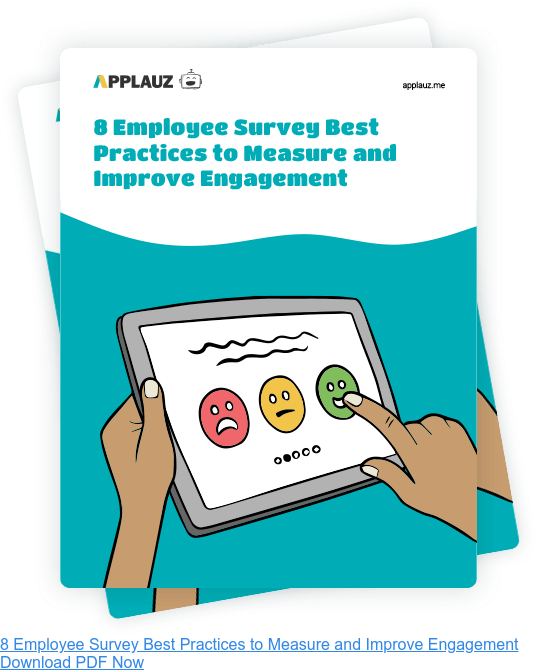MONTHLY NEWSLETTER:
Subscribe and join our community of curious HR Professionals and Managers.
Latest Article
Categories
Quick Links
Applauz Blog
Published: January 9, 2020
Last Updated: February 7, 2024
7 min read
By: Michelle Cadieux

Learn how to measure employee engagement effectively with both qualitative and qualitative methods. This way, you will always get the full picture.
You want to grow employee engagement in your workplace. But before you do, it’s critical to have an understanding of how workers feel about their jobs. Otherwise, your engagement strategies and tactics risk being misguided.
At best, they will be temporary band-aids. At worst, they will make employees feel more cynical, and ultimately, disengaged.
In other words, improving employee engagement should begin with a genuine desire to understand employees. And putting a number to employee engagement with a score or hard metric is only part of the picture. To truly improve employee engagement, you must gain a real sense of what matters to employees and listen to what they have to say.
To that end, measuring employee engagement takes a multi-level approach. It would be best if you started with hard metrics and then moved onto more qualitative measures.
For example, using hard metrics would mean measuring engagement with a number, like turnover rate.
This approach is an essential first step. A low turnover rate, for example, gives you an idea of the quality of your employee offering and experience.
But there is a big drawback; hard metrics say very little about why employees are unhappy. Or, more importantly, what kinds of solutions they would like to see from your company.
For instance, imagine someone asked you to rate how happy you felt about your job on a scale of 0-10. If you answered with a 6 out of 10, what would that say about your job? Not a lot other than the score is low.
Next, the second phase of measuring engagement comes in -- understanding why employees are unhappy, and what matters.
Achieving this goal requires observational methods of gathering feedback. For example, you can do this through short-form surveys or interviews with employees.
In this article, we will cover each phase of measuring employee engagement.
By the end, you’ll understand the complete picture of what it takes to know how your employees are feeling. Not just on a superficial level, but digging deeper to understand the source of the problem.
This may seem like a lot of work at first. But it will only benefit your company in the long run. By identifying the core of the problem, you’ll be able to put the right solutions in place, rather than coming up with band-aid tactics that quickly lose impact.


How to Measure Employee Engagement and Loyalty
Let's start with hard numbers. Hard metrics and engagement KPIs are not all bad; they have their benefits. And the main one is that they are an important general barometer of employee satisfaction.
As such, it's important to track these key metrics over a period of time so you can gain an understanding of if you have an employee engagement problem in the first place.
This metric is based on the "Net Promoter Score," which was initially developed for businesses to measure customer loyalty.
The eNPS score applies the same method to assess employee loyalty.
The eNPS score is important for managers and HR because it measures employee commitment, asking the question: how likely are you to recommend this company as a great place to work?
Employees respond on a sliding scale of 1-10, from very likely to highly unlikely. Based on employee responses, workers are classified into three categories: detractors, passives and promoters.
While this metric will not dig into why employees don't recommend your organization, it does an excellent job of collectively assessing a global picture of how dedicated your workers are.
Voluntary turnover occurs when an employee leaves a company of their own volition. It is a traditional metric for measuring employee satisfaction. Naturally, the higher your voluntary turnover rate, the more likely there is a deeper, systemic issue affecting your workforce.
To that end, consistently measuring your turnover rate is important. Doing so will give you a general sense of how happy employees are. But without further investigation, you never understand the more important question -- why. Why are employees leaving?
Exit interviews are often conducted to answer this question. But as you know, not everyone is perfectly candid when exiting a company. This is why other types of anonymous surveys should be administered to get to the bottom of the issue. We cover those in the next section of this article.
Happy employees are the foundation of customer satisfaction. So, if you're managing customer-facing employees, one of the best measures of employee engagement is how satisfied your customers are with their service.
Employees that deliver top customer service intentionally go beyond the minimum of what is expected. Passion and ownership underpin their work. There is a personal and intrinsic motivation present. Simply put, if your customers are happy, your employees are probably happy at their jobs too.
Measuring customer satisfaction is possible with several methods. It can be done quantitatively with formal customer satisfaction surveys, or more casually through conversation or feedback.
Either way, when you make an effort to gather insights from customers, you'll quickly understand how satisfied they are, and in extension, how happy your employees are as well.
Absenteeism occurs when employees regularly fail to show up for work. It can negatively impact productivity, and it's a red flag for employee disengagement.
This metric measures the percentage of employees who were absent over a given time. Higher percentages can indicate high levels of employee disengagement.
Absenteeism rates are a good barometer for employee sentiment. However, this metric does not tell you anything about why employees are frequently missing work. The root cause of employee disengagement must be addressed for absenteeism issues to be truly resolved.
In the traditional sense, productivity is about meeting a certain output within a given time period. When quality or quantity of employee output begins to suffer, this is often a sign of employee disengagement.
For example, an employee consistently misses their daily or monthly quotas, or they begin delivery work of poor quality — with apparent errors and lack of attention to detail.
That said, it can be difficult for HR to keep track of employee productivity, as they are more likely to be removed from the day-to-day of employees. But there are project management and performance tracking tools that help businesses centralize productivity data. As a result, both managers and HR can have a 360 overview of employee performance. And in extension, companies can use behavioural data to help understand overall employee happiness and satisfaction.
You are probably dealing with a high employee turnover rate or low eNPS score at this point in your investigation.
In other words, you know your employees are dissatisfied, but you are unsure as to why. Or maybe you even know which area of the work environment they are unhappy with. Still, you want to gain a clearer understanding of the problem.
Now you need to turn to more qualitative methods of measuring employee engagement. This means gathering information through surveys, one-on-one interviews, and other ways that help you collect more detailed insights into the underlying issues.
Modern survey tools help companies keep their finger on the pulse of employee sentiment. This is why these tools are often called Pulse Surveys.
Although we put it under qualitative methods, in reality, a Pulse Survey tool is both quantitative and qualitative. These tools come with reporting features that offer HR a high-level scoring system, like a “satisfaction score” so HR can put a hard number on how happy employees are.
However, pulse questions are often categorized by theme or topic, so you can quickly drill down to further qualify which area of the experience you need to focus on. And the fact that they are anonymous is critical.
That said, Pulse Surveys do help dig a bit deeper to uncover problem areas, for example, revealing that employees are unsatisfied with the leadership in your company. Yet, they still can't fully answer why that might be the case. And most importantly, which solutions will best address their problems. More investigation is necessary, so you can come up with proper solutions that are aligned with your employees' needs.
Anonymous short-form surveys are where you will get the meatiest insights. That’s because these types of surveys should be designed to drill down into very specific topics.
For example, they can investigate satisfaction with management or with perks and benefits. These highly specific surveys are the best way to gain rich information from your employees about why they are unhappy with a particular area of the workplace and what your company can do to fully address the issue.
That said, it’s important to remember these types of surveys should come after you’ve identified your “problem areas” with a Pulse Survey tool or a longer-form survey. Or simply after receiving feedback from employees and managers.
The experience of individual employees varies widely, and it's critical to understand these nuances to come up with a concrete action plan that will work in the long run.
A common method of gauging employee engagement levels is through direct interviews with employees. Typically, this method is the most time-consuming and intensive. As such, it’s generally reserved for investigating more serious issues in depth. Many companies may even outsource this work to third parties to help with the task or hire specialists for this task.
However, these one-on-one interviews can be done more efficiently. For example, by institutionalizing quarterly 1:1 meetings with managers. Each team manager is responsible for helping collect employee feedback. HR can design a roadmap or questions for these quarterly conversations. The goal is to gather specific information about employee satisfaction.
That said, this method also has an important drawback to keep in mind -- interviews are not anonymous. It’s important to consider incorporating anonymous feedback systems in your investigations as well.
Aiming to interview every employee regularly can be a big undertaking. So, focus groups are a useful alternative. Taking a few employees from each department and interviewing them in a group setting. This task can be achieved more quickly. And it's less draining on your time and resources.
However, one main drawback is that, again, face-to-face interviews are never anonymous. As such, you can’t expect everyone to be perfectly honest. This is especially true if your company is dealing with a culture where psychological safety is lacking, and employees are afraid of speaking up.
Exit interviews are a prime opportunity to collect feedback about employee experience. Since departing employees are generally more candid than those still in their jobs.
The information you gather from exit interviews will tell an interesting story. Ultimately, the feedback you receive from departing employees can help you to identify problem areas within your business. And in extension, it can give you insights that will help you better plan your employee engagement strategies.
Too often, companies pay attention to employee satisfaction only when there is a fire. For example, when turnover rates occur among talent or senior managers in their company.
Hasty solutions follow in a misguided effort to solve the problem. This approach is akin to trying to cure a cavity by brushing your teeth; the root of the issue never gets resolved.
On the other hand, look at companies where employee engagement is continuously high. It's no accident. It's by design.
These companies are deliberate about engaging employees -- they never wait for a fire. Instead, they take a preventative approach. They keep track of engagement KPIs like turnover rate. And more importantly, they devote time to collecting feedback with systems like Pulse Surveys and employee interviews.
With this approach, these companies are in the best position to develop relevant HR initiatives. Ones that keep their employer brand and experience competitive and their workers happy and engaged.
Category Tags
Employee Engagement
MONTHLY NEWSLETTER:
Subscribe and join our community of curious HR Professionals and Managers.

7675 Blvd Saint-Laurent,
suite 201,
Montreal, QC,
CA, H2R 1W9
7675 Blvd Saint-Laurent, suite 201, Montreal, QC, CA, H2R 1W9
Contact us
1 833 277 5289
Contact us | 1 833 277 5289
Follow us on LinkedIn:
© Copyright 2024. All Rights Reserved